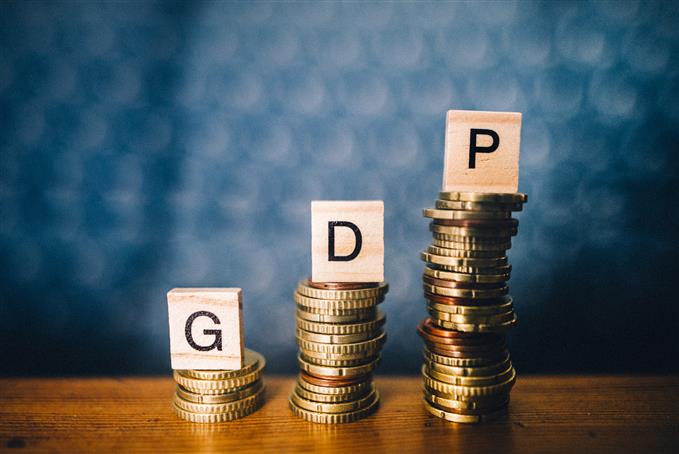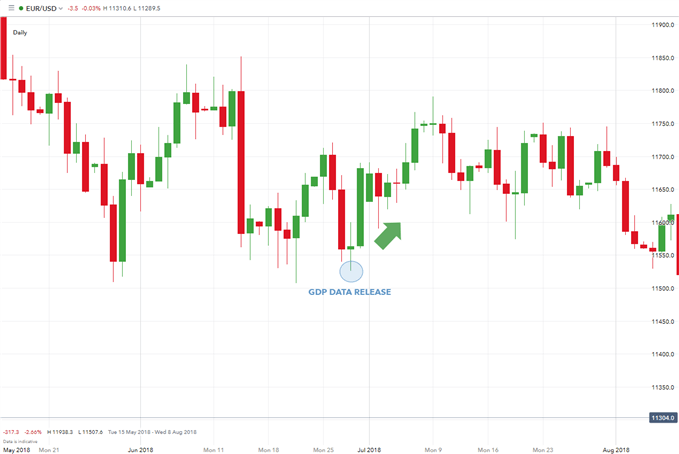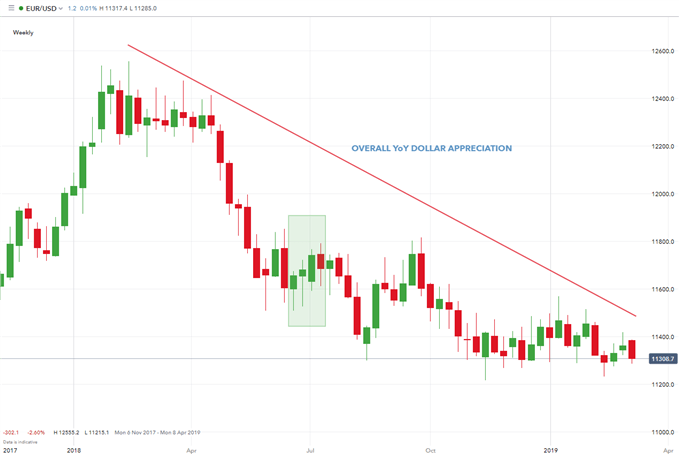forex trading
forex trading |
- Forex Trading Tips for Scalpers - Foreign Policy 2018
- A Guide to GDP and Forex Trading - DailyFX
- Why Forex Trading is the Best Trading Asset in 2019 - INSCMagazine
| Forex Trading Tips for Scalpers - Foreign Policy 2018 Posted: 18 Mar 2019 07:55 AM PDT In forex trading, there is no wrong or right way to trade. There are only profitable and non-profitable trading methods. Forex scalping is one of the several trading methods alongside intraday and swing trading strategies that are employed by most forex traders. Scalping requires passionate traders as it deals with waiting for favorable signals in the market. It involves swift opening and liquidation of trading positions which is done in small time frames ranging from 1 minute to 5 minutes. It is ideal for those seeking to make money over a short period rather than waiting for the long term. However, for you to reap marginal profits in scalp trading, you have to understand various technical analysis and be ready to spend several hours analyzing the market. The most important thing about forex scalping is that as an investor, you don't hold any share or asset for a long time. It means you can prevent losses quickly and still make small but frequent profits. The secret is to remain pretty sharp and be ready to respond quickly to changes in the market. Trading Tips for Scalpers  Have a technical analysis tool in place Having a technical analysis tool in place for your currency should be the first consideration in scalp trading. It could be active graphs or candlestick charts and more to display current currency prices from time to time. Trading should be done during active market sessions as this is when you can find good scalping opportunities. Additionally, you already know that that you shouldn't hold on to an investment for quite a long time. Therefore, as a smart trader, you need to consider the trading volumes. Devise a strategy that allows you to execute a stop-loss and grab as many small marginal profits as possible. Most advanced traders can execute as many as 100 trades per day and get away with handsome money. Understand how to read and use scalp trading indicators You will find tools like Relative Strength Index, Support and Resistance Metrics, Bollinger Bands, and Awesome Oscillator. How to scalp with Relative Strength Index RSI measures the most recent changes in currency prices. You then use the data to test whether the currency has been oversold or overbought. This helps you to know the right time to buy or sell. RSI uses average profit and losses incurred over a certain period. It gives you values of particular assets or currencies.  Scalping with Support & Resistance Metrics Support is used to describe a point of strong and stable demand. It helps to cushion against price falls. Resistance, on the other hand, is a point of strong selling that safeguards against more price hikes. It is vital that you understand these two critical points. The moment the price goes above the upper line, the support changes as well. Using Bollinger Bands BB was coined in by John Bollinger. Bollinger Band uses a moving average technique together with two other trading bands at both ends. BB calculates the standard deviation through subtraction and addition. It has two price channels that act as standard deviation and one central line that acts as an exponential function showing the moving average. The expansion and contraction of the bands display price movements. It can either be volatile or limited to a tight trading pattern. Scalping with Awesome Oscillator  AO is another indicator that offers an attractive way to do scalp trading. Oscillator indicator evaluates market momentum. It shows the period space of simple moving average and runs from 34-5. SMA is calculated by considering the midpoints of every individual bar. When the bar rises above zero, then it is the right time to buy. It shows a transition from negative to positive. Risk management As a smart scalper, you need to have a profitable scalp trading strategy with a higher win/loss ratio. Experts recommend that you leverage 15% of your purchasing power for every scalp trade you do. Your risk in every trade should be small and stop-loss order next to your entry point. It is advisable to ensure that your risks should not go beyond 1% of your purchasing power. Learn to scalp small and lightly. Conclusion For you to succeed in scalp trading, you need to open an account with forex brokers that allow scalping strategy and you need to have solid trading strategies in place. Most of these strategies are not different from other short-term forex trading techniques. Among the top secrets to consider include having proper technical analysis tools in place, knowing how to manage risks and understanding how to read indicators such as RSI, S&R, AO, and BB. |
| A Guide to GDP and Forex Trading - DailyFX Posted: 12 Mar 2019 06:41 AM PDT  GDP (Gross Domestic Product) economic data is deemed highly significant in the forex market. GDP figures are used as an indicator by fundamentalists to gauge the overall healthand potential growth of a country.Consequently, greater volatility in the forex market is closely observed during the GDP release. What forex traders need to know about GDPWhat is GDP? Developed in 1934 by Simon Kuznets, the Gross Domestic Product (GDP) measures the output and production of finished goods in a country's economy. Usually, GDP is measured in three different time periods: monthly, quarterly and annually. This enables economists and traders to get an accurate picture of the overall health of the economy. There are many approaches to calculating GDP, however, the US Bureau of Economic Analysis uses the "Expenditure Approach" using the formula: GDP = Consumption (C) + Investment (I) + Government Spending (G) + (Exports (X) - Imports (M)) Understanding the relationship between GDP and the forex market The general rule of thumb when looking at GDP data is looking at whether figures beat or fall below estimates (see relevant charts below):
EUR/USD chart: Low GDP data release 
EUR/USD chart: High GDP data release  GDP reports do not always have the same or expected effect on currencies. This is important to keep in mind before committing to a trade. Often, GDP figures are already fully/partially priced into the market meaning that the market may not react as anticipated once GDP figures are released. Related economic data reports regularly allow for the market to ascertain a somewhat accurate estimate. Data to look out for: Analysing GDP data to inform currency trading decisionsGDP, Inflation and Interest Rates The advance release of GDP is four weeks after the quarter ends while the final release happens three months after the quarter ends. Both are released by the Bureau of Economic Analysis (BEA) at 08:30 ET. Typically, investors are looking for US GDP to grow between 2.5% to 3.5% per year. Without the specter of inflation in a moderately growing economy, interest rates can be maintained around 3%. However, a reading above 6% GDP would show that the US economy is endanger of overheating which can, in turn, spark inflation fears. Consequently, the Federal Reserve may have to raise interest rates to curb inflation and put the 'brakes' on an overheating economy. Maintaining price stability is one of the jobs of the Federal Reserve. GDP must stay in a 'goldilocks range': not too hot and not too cold. GDP should not be high enough to trigger inflation or too low where it could lead to recession. A recession is defined by two consecutive negative quarters of GDP growth. The GDP 'sweet spot' varies from one country to another. For example, China has had GDP in double digits. Forex traders are most interested in GDP as it is a complete health report card for a country's economy. A country is 'rewarded' for a high GDP with a higher value of their currency. There is usually a positive expectance for future interest rate hikes because strong economies tend to get stronger creating higher inflation. This, in turn, leads to a central bank raising rates to slow growth and to contain the growing specter of inflation. On the other hand, a country with weak GDP has a drastically reduced interest rate hike expectation. In fact, the central bank of a country that has two consecutive quarters of negative GDP may even choose to stimulate their economy by cutting interest rates. Trading currency pairs using GDP dataQuarter-on-quarter figures tend to produce much more variable changes in the overall trend – e.g. Positive GDP figures beating estimates QoQ may be fleeting when taking into consideration year-on-year (YoY) data. YoY data allows for a broader perspective which could potentially highlight an overall trend. The chart below shows a longer time frame EUR/USD view as seen in Chart 2 above. This chart expresses the variation in short term QoQ data against the longer-term YoY trend.  GDP and economic data: Top tips for FX traders
|
| Why Forex Trading is the Best Trading Asset in 2019 - INSCMagazine Posted: 18 Mar 2019 05:25 AM PDT INSCMagazine: Get Social! Forex trading is usually preferred to other financial markets, mainly because of its low spreads and high leverage. As you can imagine, trading on the world's largest and most liquid financial market comes with more than just two advantages. Find out more about forex, how you can trade it and why it should be your top choice in 2019. The Foreign Exchange Market – Overview The Forex Market, also referred to as the FX, Foreign exchange or Foreign currency market, is the largest, most liquid decentralized market in the world, with a daily turnover that exceeds $5 trillion. In this marketplace – banks, businesses, companies and individual investors exchange and speculate on currencies. The FX market is open 24/5 and brokers usually operate from Sunday at 4:00 pm EST until Friday at 4:00 pm EST. The ideal time to open a position is during an overlapping session relevant to the currency pair you're trading. The four major overlapping sessions are the following:
How Forex Trading Works Trading forex means buying or selling a currency, by speculating on the price of one currency against another. The one currency you sell or spend is called the base currency, while the one that you purchase is known as the quote currency. Together they form a currency pair. In forex, the sell price is known as the bid, while the buy price is the offer, whereas the difference between them is called the spread and represents the cost of the trade. There are three types of currency pairs: major, minor and exotic. The first category is the most actively traded and its main characteristic is the presence of the USD as either the base or quote currency in all the pairs. This category includes the EUR/USD (Euro/US dollar), USD/JPY (US dollar/Japanese yen), and the GBP/USD (British pound/US dollar). The minor currency pairs, also known as crosses, do not include the US dollar at all. Some of the most traded currency pairs from this category are the EUR/GBP (Euro/British pound), the EUR/AUD (Euro/Australian dollar), and the GBP/JPY (British pound/Japanese yen). Finally, exotic currency pairs are less liquid and have higher spreads. They are typically formed from a major currency and a currency from a country with a developing economy. This category includes the EUR/TRY (Euro/Turkish lira), the JPY/NOK (Japanese yen/Norwegian krone), and the USD/HKD (US dollar/Hong Kong dollar). Trading forex is possible by opening an account with an online forex broker. TradeFW.com is a licensed and regulated award-winning broker that gives you access to this exciting market and provides you with a modern & professional trading environment, as well as a large quantity of educative materials to help you succeed. The importance of the broker you choose is crucial for your results, so don't neglect it! Factors That Influence the Forex Prices While many factors contribute to the outcome of your trades, there are certain variables you need to analyze when trading a currency pair.
Why Forex can be more profitable than other assets Let's begin with the most obvious and appealing advantage – the outstanding volatility! The daily trading volume of this market surpasses $5 trillion, in comparison to the second largest financial market, the stock market, which trades around $200 billion per day. Let that sink in! This great volatility brings along a great number of trading opportunities that wait for you every moment! Moreover, trading forex implies lower costs (commission + spread) compared to other assets, where additional fees are charged. Brokers usually make this feature better by allowing you to trade with appealing leverage ratios. For example, TradeFW provides its clients with a ratio of up to 1:30, meaning that they can trade up to 100k using just 3333 of their own funds. Another advantage that makes Forex better than its "peers" is the fact that the market operates 24 hours, five days per week. This flexibility allows all types of traders to approach their strategies efficiently without the pressure of a tight schedule. Conclusion The Forex market is the world's largest and most liquid financial market, filled with endless trading opportunities. Its set of unique advantages and features maintain it the most popular and lucrative trading asset, so don't hesitate to make 2019 the year that marks the beginning of your forex trading journey. |
| You are subscribed to email updates from "forex trading" - Google News. To stop receiving these emails, you may unsubscribe now. | Email delivery powered by Google |
| Google, 1600 Amphitheatre Parkway, Mountain View, CA 94043, United States | |
Comments
Post a Comment